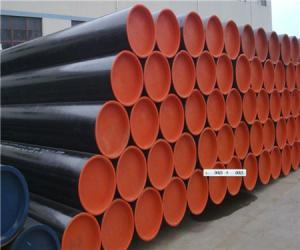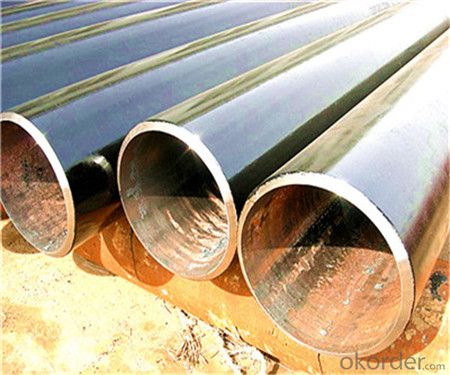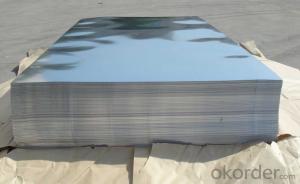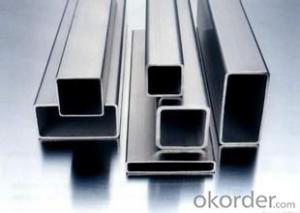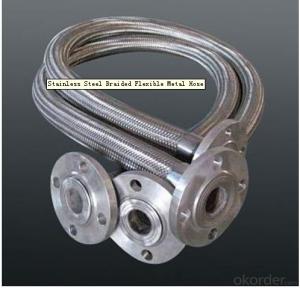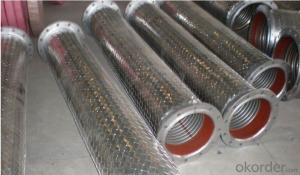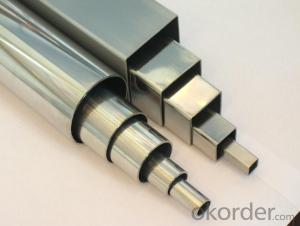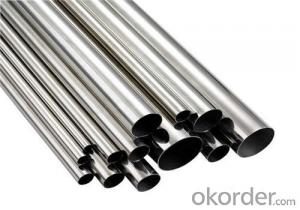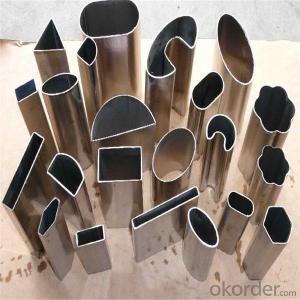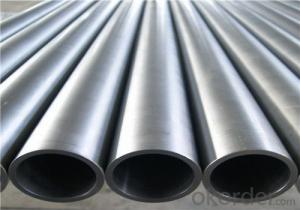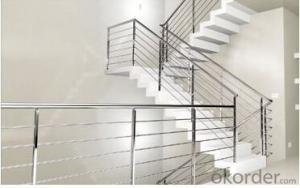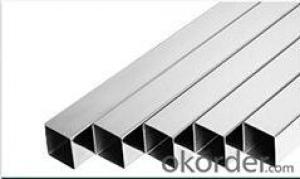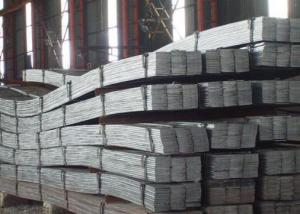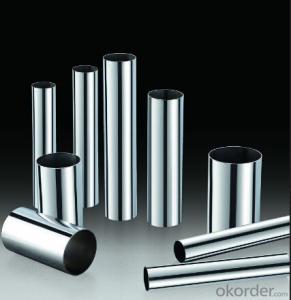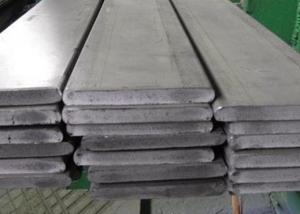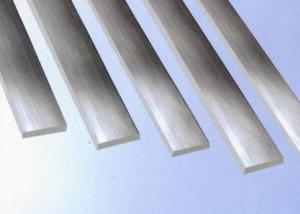Regular Stainless Steel Square Pipe 304,316,201 Supplier
- Loading Port:
- China Main Port
- Payment Terms:
- TT or LC
- Min Order Qty:
- 30 m.t.
- Supply Capability:
- 12000 m.t./month
OKorder Service Pledge
OKorder Financial Service
You Might Also Like
1、Structure of Seamless Pipe ASTM A106/53:
Seamless pipe is formed by drawing a solid billet over a piercing rod to create the hollow shell. As the manufacturing process does not include any welding, seamless pipes are perceived to be stronger and more reliable. Historically seamless pipe was regarded as withstanding pressure better than other types, and was often more easily available than welded pipe.
Packing and shipment
Packaged in bundles,as per customers' requirements, it can also bepackagesd as beveled ends, typed marking, black painting, plastic caps protection,woven bags packing
For 20" container the max length is 5.8m; For 40" container the max length is 12m. other options are available based on customer requests. Please discuss when placing orders.
2、Main Features of the Seamless Pipe ASTM A106/53:
• High manufacturing accuracy
• High strength
• Small inertia resistance
• Strong heat dissipation ability
• Good visual effect
• Reasonable price
3、Seamless Pipe ASTM A106/53 Specification:
Standard | GB, DIN, ASTM ASTM A106-2006, ASTM A53-2007 |
Grade | 10#-45#, 16Mn 10#, 20#, 45#, 16Mn |
Thickness | 8 - 33 mm |
Section Shape | Round |
Outer Diameter | 133 - 219 mm |
Place of Origin | Shandong, China (Mainland) |
Secondary Or Not | Non-secondary |
Application | Hydraulic Pipe |
Technique | Cold Drawn |
Certification | API |
Surface Treatment | factory state or painted black |
Special Pipe | API Pipe |
Alloy Or Not | Non-alloy |
Length | 5-12M |
Outer Diameter | 21.3-610mm |
Grade | 20#, 45#, Q345, API J55, API K55, API L80, API N80, API P110, A53B |
Standard | ASME, ASTM |
4、Packaging & Delivery
Packaging Details: | seaworthy package,bundles wrapped with strong steel strip |
Delivery Detail: | 15-30days after received 30%TT |
5、FAQ of Seamless Pipe ASTM A106/53:
①How is the quality of your products?
Our products are manufactured strictly according to national and internaional standard, and we take a test
on every pipe before delivered out. If you want see our quality certifications and all kinds of testing report, please just ask us for it.
Guaranteed: If products’ quality don’t accord to discription as we give or the promise before you place order, we promise 100% refund.
②How about price?
Yes, we are factory and be able to give you lowest price below market one, and we have a policy that “ for saving time and absolutely honest business attitude, we quote as lowest as possible for any customer, and discount can be given according to quantity”,if you like bargain and factory price is not low enough as you think, just don’t waste your time.Please trust the quotation we would give you, it is professional one.
③Why should you chose us?
Chose happens because of quality, then price, We can give you both.Additionally, we can also offer professional products inquiry, products knowledge train(for agents), smooth goods delivery, exellent customer solution proposals.Our service formula: good quality+good price+good service=customer’s trust
SGS test is available, customer inspection before shipping is welcome, third party inspection is no problem.
6、Seamless Pipe ASTM A106/53 Images:
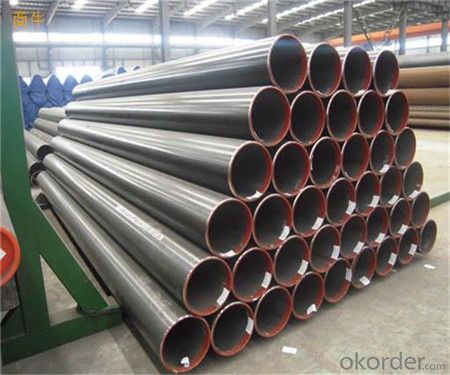
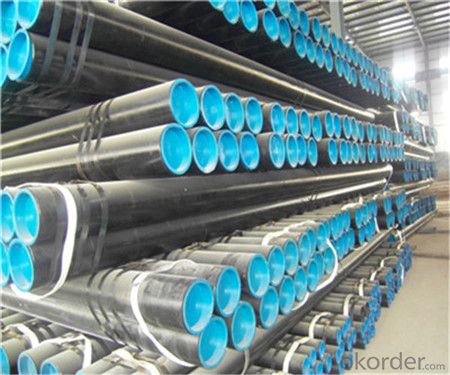
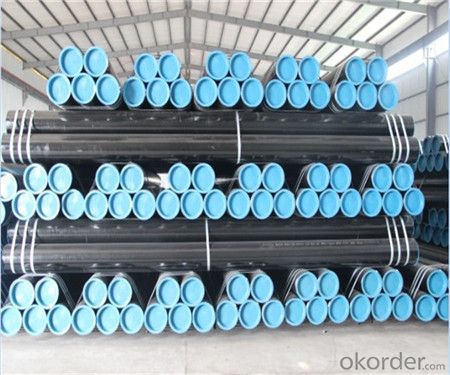
- Q: Can stainless steel pipes be used for firefighting systems?
- Firefighting systems can utilize stainless steel pipes due to their durability and resistance to corrosion. The material's ability to withstand heat, pressure, and chemicals makes it suitable for transporting water, foam, and other fire suppression agents. In addition to its high strength and ability to endure extreme conditions, stainless steel pipes are also recognized for their smooth inner surface, which reduces friction loss and maximizes water flow. This quality is crucial for the effectiveness of firefighting operations. Overall, stainless steel pipes offer a dependable and long-lasting solution for firefighting systems, ensuring safety and efficiency in critical situations.
- Q: Can stainless steel pipes be used for brewery equipment?
- Yes, stainless steel pipes can be used for brewery equipment. Stainless steel is an ideal choice for brewery equipment due to its corrosion resistance, durability, and ability to maintain the integrity of the beer. Stainless steel pipes do not react with the beer or any cleaning and sanitizing agents used in the brewing process, ensuring the purity and taste of the final product. Additionally, stainless steel pipes are easy to clean and maintain, reducing the risk of contamination and allowing for efficient operations in the brewery.
- Q: Can stainless steel pipes be used for underground sprinkler systems?
- Yes, stainless steel pipes can be used for underground sprinkler systems. Stainless steel is known for its durability, resistance to corrosion, and ability to withstand high pressure and temperature. These qualities make it an excellent choice for underground applications, where the pipes are exposed to moisture, soil, and other environmental factors. Additionally, stainless steel pipes are non-reactive, meaning they will not contaminate the water supply or affect the quality of the water being used for irrigation. However, it is important to ensure that the stainless steel pipes are properly installed, with appropriate fittings and connections, to ensure a reliable and efficient sprinkler system.
- Q: Are stainless steel pipes suitable for automotive applications?
- Yes, stainless steel pipes are suitable for automotive applications. Stainless steel is a highly durable and corrosion-resistant material, making it ideal for use in automobile components that are exposed to harsh environments, such as exhaust systems and catalytic converters. Stainless steel pipes offer excellent resistance to heat, chemicals, and abrasion, ensuring long-lasting performance in automotive applications. Additionally, stainless steel is lightweight and has high strength, which contributes to improved fuel efficiency and overall vehicle performance.
- Q: What are the specifications of stainless steel decorative pipes?
- Decorative tubes, then more specifications. Our factory has the smallest 9.5MM, the largest to see how big you can, directly with the industrial pipe to polish it
- Q: Can stainless steel pipes be used for steam applications?
- Yes, stainless steel pipes can be used for steam applications. Stainless steel is known for its high temperature resistance and corrosion resistance, making it suitable for steam systems. It can withstand the high pressure and temperatures that steam applications require without deforming or corroding. Stainless steel pipes are also durable and have a long lifespan, making them a reliable choice for steam applications. Additionally, stainless steel pipes can be easily welded, ensuring a secure and leak-free steam system.
- Q: What is the difference between seamless and seamless redrawn stainless steel pipes?
- The main difference between seamless and seamless redrawn stainless steel pipes lies in their manufacturing processes. Seamless stainless steel pipes are produced from solid billets without any seams or welded joints, resulting in a smooth and continuous pipe. On the other hand, seamless redrawn stainless steel pipes are initially produced through the seamless process, but then they undergo additional drawing or resizing processes to achieve more precise dimensions, smoothness, and improved surface finish. Overall, seamless redrawn stainless steel pipes offer enhanced precision and surface quality compared to standard seamless pipes.
- Q: How do you prevent galling in stainless steel pipes?
- Galling, also known as cold welding, is a common issue in stainless steel pipes that can lead to damage and failure if not properly addressed. There are several steps that can be taken to prevent galling in stainless steel pipes: 1. Lubrication: Applying a suitable lubricant to the threaded connections can significantly reduce the risk of galling. Lubricants create a barrier between the mating surfaces, reducing friction and preventing the metal-to-metal contact that can lead to galling. It is important to use a lubricant specifically designed for stainless steel to ensure compatibility and effectiveness. 2. Proper pipe installation: Correct installation techniques play a crucial role in preventing galling. It is important to avoid over-tightening the connections as this can increase the risk of galling. Following the manufacturer's recommended torque specifications and using a calibrated torque wrench can help ensure proper installation without causing excessive stress on the threads. 3. Avoiding dissimilar metals: When connecting stainless steel pipes, it is important to avoid using dissimilar metals in the joint. Galvanic corrosion can occur when dissimilar metals come into contact, leading to galling. If dissimilar metals must be used, isolating gaskets or other insulating materials can be employed to prevent direct contact between the metals. 4. Surface finish: Maintaining a smooth surface finish on the threads can help reduce the risk of galling. Rough or damaged threads can create areas of high friction, increasing the likelihood of galling. Thoroughly inspecting and cleaning the threads before installation can help identify any imperfections that need to be addressed. 5. Material selection: Choosing the right grade of stainless steel is essential in preventing galling. Certain stainless steel alloys, such as 304 and 316, are more resistant to galling due to their higher nickel content. Consulting with a materials expert or referring to industry standards can help determine the most suitable stainless steel grade for a specific application. By implementing these preventive measures, the risk of galling in stainless steel pipes can be significantly reduced, ensuring the longevity and reliability of the piping system.
- Q: Are stainless steel pipes suitable for brewery applications?
- Yes, stainless steel pipes are highly suitable for brewery applications. Stainless steel is a preferred material in the brewing industry due to its excellent corrosion resistance, durability, and hygienic properties. These pipes can withstand the harsh conditions of a brewery environment, including exposure to hot liquids and cleaning chemicals, without corroding or contaminating the beer. Stainless steel pipes also have a smooth surface, which helps prevent the buildup of bacteria and other contaminants, ensuring a high level of cleanliness and quality in the brewing process. Additionally, stainless steel is easy to clean and maintain, making it a practical choice for breweries. Overall, stainless steel pipes are a reliable and efficient option for brewery applications.
- Q: What is the difference between electropolished and bright annealed stainless steel pipes?
- Electropolished stainless steel pipes undergo a process called electropolishing, which involves the removal of surface impurities and oxidation through an electrochemical process. This results in a smooth, shiny, and corrosion-resistant surface finish. On the other hand, bright annealed stainless steel pipes are heat-treated to achieve a bright, reflective surface finish. While both processes enhance the aesthetics of the pipes, electropolishing provides additional benefits such as improved cleanability and increased resistance to corrosion.
Send your message to us
Regular Stainless Steel Square Pipe 304,316,201 Supplier
- Loading Port:
- China Main Port
- Payment Terms:
- TT or LC
- Min Order Qty:
- 30 m.t.
- Supply Capability:
- 12000 m.t./month
OKorder Service Pledge
OKorder Financial Service
Similar products
Hot products
Hot Searches
Related keywords
